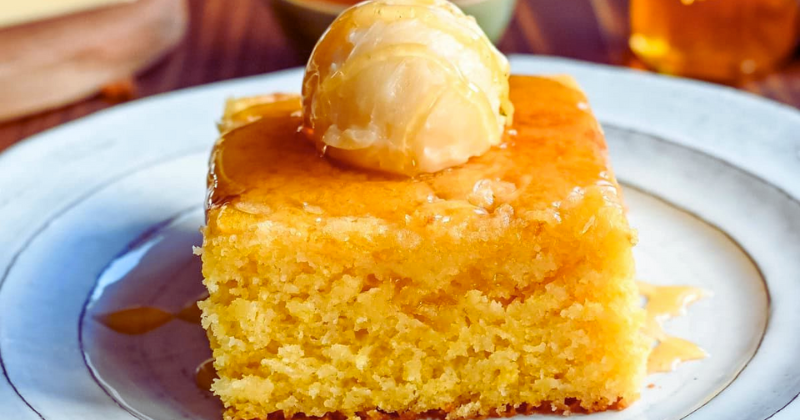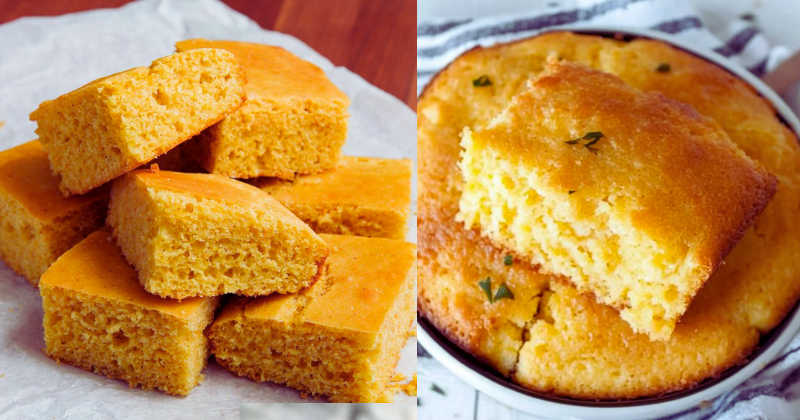Prep Time: 15 minutes | Cook Time: 35 minutes | Total Time: 50 minutes | Serves: 8-10 | Difficulty: Easy
Every family has that one recipe that instantly transports you back to childhood – for me, it’s my grandmother’s sweet cornbread cake. I can still remember the golden aroma wafting from her cast-iron skillet on Sunday afternoons, promising something magical was about to emerge from the oven. This wasn’t your typical dry, crumbly cornbread; this was something special – a tender, moist cake with that perfect balance of corn sweetness and comforting warmth that made every bite feel like a hug.
What makes this sweet cornbread cake so extraordinary is how it bridges the gap between traditional cornbread and dessert cake. Unlike regular cornbread that often serves as a side dish, this version stands proudly on its own as a delightful treat that’s equally at home with morning coffee or as an evening dessert. The secret lies in the perfect ratio of cornmeal to flour, creating a texture that’s both substantial and delicate.
Why You’ll Love This Sweet Cornbread Cake Recipe
This homemade sweet cornbread cake will quickly become your go-to comfort food for several compelling reasons. First, it’s incredibly easy to make – even novice bakers can achieve bakery-quality results with simple pantry ingredients and basic mixing techniques. The one-bowl method means minimal cleanup, making it perfect for busy weeknights or spontaneous weekend baking.
Second, this recipe delivers exceptional versatility. Serve it warm with butter and honey for breakfast, pair it with chili or soup for dinner, or dress it up with fresh berries and whipped cream for dessert. The naturally family-friendly flavor appeals to all ages, making it ideal for potlucks, holiday gatherings, or whenever you need a crowd-pleasing treat.
Third, the texture is absolutely divine – moist, tender, and perfectly crumbly without being dry. The cornmeal adds a delightful subtle grittiness that creates textural interest, while the cake remains soft and springy. Finally, this recipe stores beautifully and actually improves in flavor over the first day, making it an excellent make-ahead option for meal planning.
Essential Ingredient Insights & Smart Selections
The foundation of exceptional sweet cornbread cake lies in choosing quality ingredients that work harmoniously together. Medium-grind cornmeal is crucial – it provides the characteristic texture without being too coarse or too fine. Look for stone-ground cornmeal when possible, as it offers superior flavor and nutritional value. Yellow cornmeal gives the most traditional appearance and taste, though white cornmeal works equally well.
All-purpose flour creates the cake’s tender structure, while granulated sugar provides sweetness and helps create moisture. Eggs act as both binding agents and leaveners, contributing to the cake’s light texture. Whole milk adds richness and tenderness – avoid using skim milk as the fat content is essential for proper texture. Vegetable oil keeps the cake moist for days, though melted butter can be substituted for richer flavor.
For dietary modifications, gluten-free flour blends work well as 1:1 substitutions, though you may need to add a binding agent like xanthan gum. Dairy-free alternatives include plant-based milk and oil instead of butter. The sugar can be reduced by up to 25% if you prefer less sweetness, or substitute with coconut sugar for a deeper flavor profile. Always use fresh baking powder and check expiration dates – old leaveners result in dense, flat cakes.
Master These Key Techniques for Perfect Results
Success with sweet cornbread cake depends on mastering several fundamental techniques that ensure consistent, professional results every time. The mixing method is critical – combine all dry ingredients thoroughly before adding wet ingredients. This prevents lumps and ensures even distribution of leavening agents. When combining wet and dry ingredients, mix just until incorporated; overmixing develops gluten and creates tough, dense cake.
Temperature control makes a significant difference in texture and appearance. Room temperature ingredients blend more easily and create smoother batters. Remove eggs and milk from refrigeration 30-60 minutes before baking, or quickly warm eggs in lukewarm water for 5 minutes. The oven should be fully preheated – this ensures proper rise and browning from the start.
Pan preparation affects both release and crust development. Generously butter your baking pan, then dust with cornmeal instead of flour for extra corn flavor and authentic appearance. Cast-iron skillets create beautifully crispy crusts, while standard cake pans produce more tender sides. The batter should sizzle slightly when it hits a preheated cast-iron pan.
Timing and visual cues prevent overbaking, which is the most common mistake. The cake is done when the top is golden brown, the edges begin pulling slightly from pan sides, and a toothpick inserted in the center comes out with just a few moist crumbs. The surface should spring back lightly when touched, and you’ll hear the characteristic gentle crackling as it begins cooling.

Step-by-Step Instructions for Sweet Cornbread Cake Perfection
Step 1: Preheat your oven to 400°F (200°C). Generously butter a 9-inch cast-iron skillet or round cake pan, then dust with cornmeal, tapping out excess. This creates a beautiful, rustic crust and prevents sticking.
Step 2: In a large mixing bowl, whisk together 1 cup yellow cornmeal, 1 cup all-purpose flour, ⅓ cup granulated sugar, 1 tablespoon baking powder, and 1 teaspoon salt. Ensure no lumps remain – this dry mixture forms your cake’s foundation.
Step 3: Create a well in the center of dry ingredients. In a separate bowl, whisk together 1 cup whole milk, 2 large eggs, and ⅓ cup vegetable oil until completely smooth. The mixture should be well-combined and slightly frothy.
Step 4: Pour the wet ingredients into the dry ingredient well. Using a wooden spoon or rubber spatula, gently fold together until just combined. The batter should be slightly lumpy – smooth batter indicates overmixing, which creates tough cake.
Step 5: Immediately pour batter into prepared pan, spreading evenly with a spatula. For cast-iron skillets, you should hear a gentle sizzle as batter hits the hot surface. Bake for 30-35 minutes until golden brown and pulling slightly from edges.
Step 6: Test doneness with a toothpick inserted in center – it should emerge with a few moist crumbs attached. Cool in pan for 10 minutes before serving warm, or completely before removing from pan. The residual heat continues cooking during the cooling period.
Professional Tips & Troubleshooting for Guaranteed Success
Achieving bakery-quality sweet cornbread cake consistently requires attention to several insider secrets. First, measure cornmeal by spooning it into measuring cups rather than scooping directly from the container – this prevents packing and ensures accurate measurements. Too much cornmeal creates dry, crumbly results.
Temperature precision matters more than many realize. If your cake consistently turns out dry, reduce oven temperature by 25°F and increase baking time by 5-10 minutes. Every oven runs differently, and slower baking often produces more tender results. Conversely, if your cake doesn’t rise properly, check that your baking powder is fresh and your oven has reached full temperature before baking.
For perfectly moist cake every time, don’t overbake – slightly underdone is better than overdone with cornbread cake. The residual heat from the pan continues cooking even after removal from oven. If your cake cracks on top, reduce oven temperature slightly next time, as this indicates too-rapid rising.
Storage technique affects texture significantly. Wrap cooled cake tightly in plastic wrap or store in airtight containers. The cake actually improves after 24 hours as flavors meld and moisture redistributes throughout. If your cake becomes dry, brush lightly with simple syrup or warm milk before serving.
Creative Variations & Dietary Customizations
Transform your basic sweet cornbread cake into exciting variations that suit different tastes and dietary needs. For chocolate lovers, add ¼ cup cocoa powder to dry ingredients and reduce flour accordingly, creating a unique chocolate-corn flavor combination that’s surprisingly sophisticated.
Fruit variations work beautifully – fold in fresh blueberries, diced peaches, or corn kernels during the final mixing stage. Citrus zest adds brightness; try lemon or orange zest with corresponding extracts. Spice variations include cinnamon, nutmeg, or cardamom for warming flavors.
For gluten-free versions, substitute cup-for-cup gluten-free flour blends, though you may need to add 1 teaspoon xanthan gum if your blend doesn’t include it. Dairy-free adaptations work with plant-based milk and oil instead of butter. Reduce sugar by up to one-third for less sweet versions, or substitute honey for different flavor profiles.
Scale recipes easily – halve all ingredients for smaller 6-inch pans, or double for large sheet pans or multiple servings. Adjust baking times accordingly, checking for doneness with the toothpick test rather than relying solely on timing.
Storage, Reheating & Make-Ahead Strategies
Proper storage maintains your sweet cornbread cake’s quality for maximum enjoyment. At room temperature, wrap tightly in plastic wrap or store in airtight containers for up to 3 days. The cake actually improves after the first day as moisture redistributes and flavors develop.
For longer storage, refrigerate wrapped cake for up to 1 week, though bring to room temperature before serving for best texture. Freeze individual slices wrapped in plastic wrap and aluminum foil for up to 3 months – this makes portion control easy and prevents waste.
Reheating requires gentle heat to prevent drying. Warm individual slices in 300°F oven for 5-8 minutes, or microwave for 15-20 seconds. For whole cakes, cover with foil and warm in 325°F oven for 10-15 minutes.
Make-ahead preparation saves time during busy periods. Mix dry ingredients up to 2 days ahead and store in sealed containers. The complete batter should be baked immediately after mixing for optimal rise and texture.
Perfect Serving Suggestions & Delicious Pairings
Sweet cornbread cake shines with both simple and elaborate accompaniments that enhance its natural corn sweetness. Classic pairings include warm butter and honey, creating a comforting combination that highlights the cake’s rustic charm. Fresh fruit like berries or peaches adds natural sweetness and beautiful color contrast.
For more sophisticated presentations, serve with whipped cream or vanilla ice cream, transforming simple cornbread into elegant dessert. Maple syrup or caramel sauce create indulgent treats perfect for special occasions. Cream cheese frosting turns this into a proper layer cake for celebrations.
Beverage pairings depend on serving time – morning coffee or afternoon tea complement the corn flavors beautifully. For evening desserts, consider sweet wines like Moscato or Riesling. The cake also pairs wonderfully with savory meals, especially chili, barbecue, or hearty soups where it serves as both bread and dessert.
Consider seasonal garnishes like candied pecans in fall, fresh mint in summer, or warming spices in winter to keep this versatile recipe exciting year-round.
Ready to Create Your Own Sweet Cornbread Cake Magic?
This sweet cornbread cake recipe represents more than just ingredients and instructions – it’s your gateway to creating lasting memories and comforting moments in your own kitchen. Whether you’re continuing a family tradition or starting a new one, this foolproof recipe delivers consistent, delicious results that will have everyone asking for seconds.
Don’t wait for a special occasion to try this recipe. Sweet cornbread cake makes ordinary days feel special and transforms simple ingredients into something truly memorable. Gather your ingredients, preheat that oven, and prepare to fill your home with the irresistible aroma of homemade comfort food at its finest.

